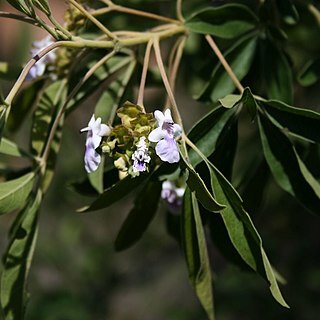Trees (2-)3-4(-9) m high; single-stemmed and well branched; cork dark grey-brown, fissured, rough, tessellate; young stems and growing points glabrous or sparsely white-pubescent. Leaves palmately compound with 3-5 pinnae; petiole (9-)30-35(-55) mm long, glabrous or sparsely white-pubescent; petiolule slender, (0-)5-6(-18) mm long, sparsely hairy; median pinna (34-)60-65(-135) x (9-)17-18(-31) mm, narrowly oblong, narrowly elliptic or lanceolate, apex as well as base acute, margin entire or toothed in upper half; yellow green to khaki; adaxial surface glabrous to sparsely pubescent, glandular, abaxial surface sparsely pubescent and glandular; chartaceous. Inflorescence a compound dichasium, total length (35-)45-60(-95) mm, sparsely white-pubescent; length of bracts at first branch of inflorescence (1-)9-10(-22) mm. Flowers with total length 6-10 mm, regular. Calyx 5-lobed, lobes 1.5-3.5 mm long; tube 3-4 mm long; external surface glandular pubescent, internal surface glandular. Corolla: tube straight 6-9 mm long; lobes 5, front view of lobes 10.0-11.0 x 6.0-6.5 mm, situated at right angles to tube; tube white, lobes mauve. Androecium didynamous, longest pair of stamens 6 mm and shortest pair 5 mm, exserted. Ovary globose or obovoid, hairy and white glandular in upper half; style 6-9 mm long. Fruit dry, obovoid, 3 x 4 mm, sessile in base of a persistent, chartaceous, campanulate calyx.
More
Tree, (2-)3-4(-9) m high. Leaflets glabrous, median leaflet narrowly oblong, narrowly elliptic or lanceolate. Calyx bell-shaped in fruit. Fruit dry, obovate. Flowers white to pale mauve.
A small tree. It has a single stem and many branches. It grows 2-9 m tall. The leaves are compound. There are 3-5 leaflets arranged like fingers on a hand.


